Key takeaways
- Grassroots movements play a significant role in shaping Louisiana’s political landscape and influencing budget allocations for essential services.
- Recent budget changes in Iberville Parish show increased funding for education and public safety, reflecting community priorities and aspirations.
- Community engagement at budget meetings highlights the direct impact of funding on services like public education and infrastructure, affecting residents’ daily lives.
- Budget allocations serve as a reflection of community values, showcasing the importance of prioritizing resources that foster growth and well-being.
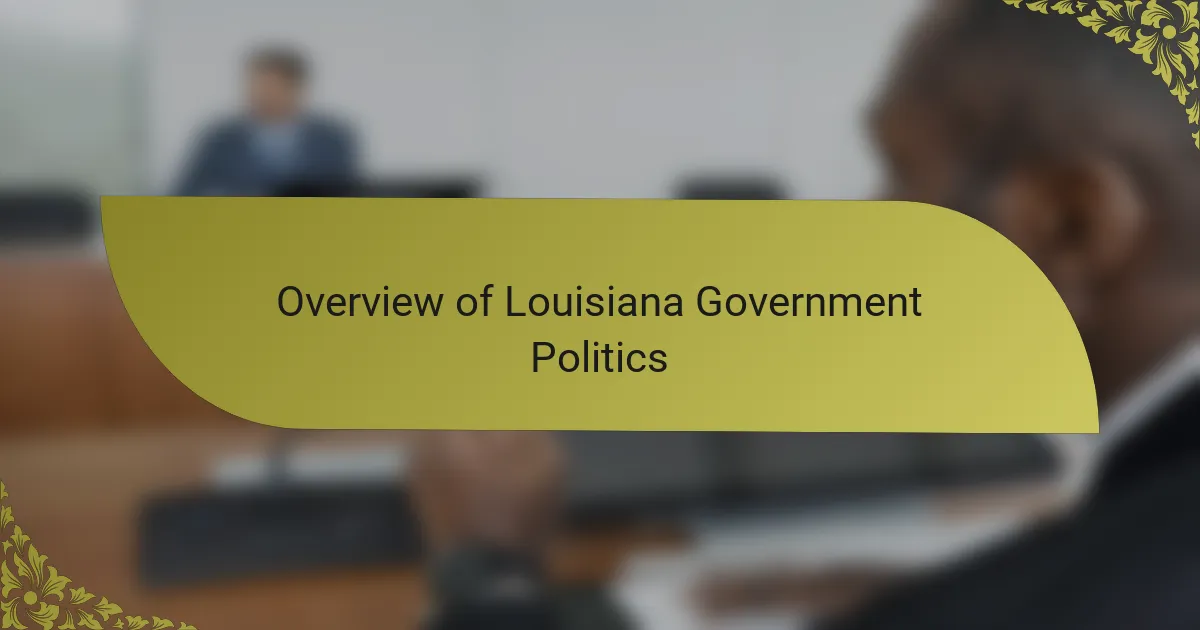
Overview of Louisiana Government Politics
Louisiana’s political landscape is as colorful and unique as its culture. I often find myself marveling at how regional identities shape the direction of local governance. The intricate dance between state leaders and local officials can sometimes feel like a complex puzzle, inviting us to consider how each piece influences the broader picture of governance.
One thing that truly fascinates me is the impact of grassroots movements in Louisiana politics. I’ve seen firsthand how community voices can drive change, highlighting the necessity of public participation in decision-making processes. It raises an important question: how can we ensure every citizen has a seat at the table when it comes to influencing budget allocations and political priorities?
In my observations, the budget process can serve as a reflection of public values and priorities. It’s intriguing to see how funding decisions not only affect services but also reveal the community’s priorities. Have you ever wondered how much of a role your voice plays in shaping these decisions? It’s powerful to recognize that, in Louisiana, each budget allocation can spark discussions about equity, representation, and future growth.
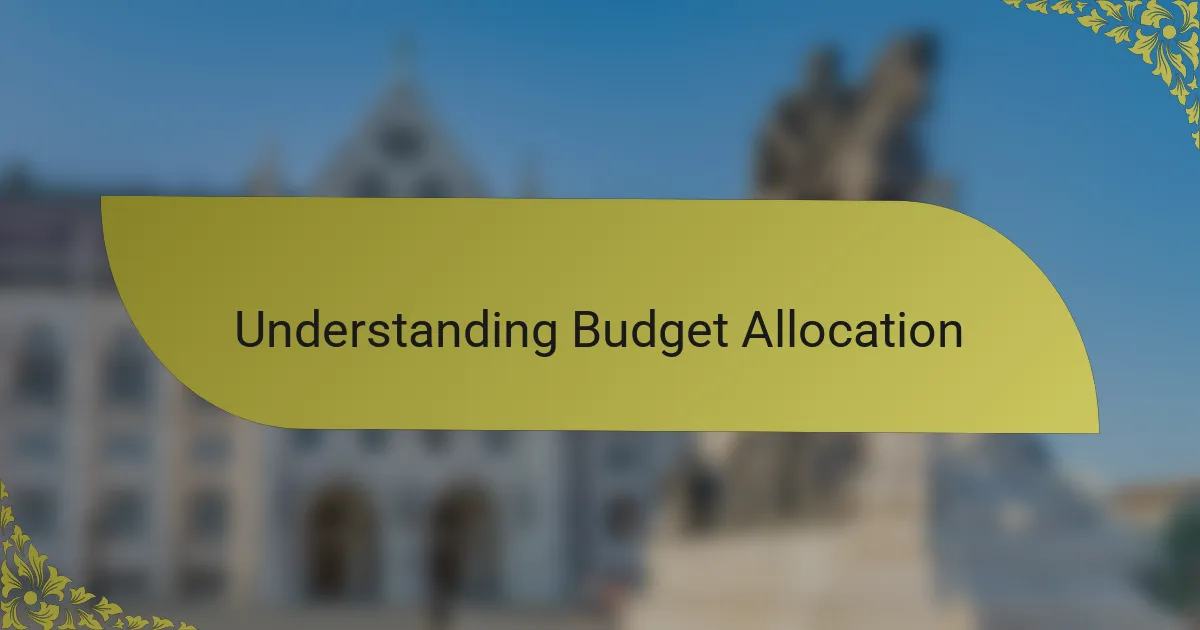
Understanding Budget Allocation
Understanding the budget allocation process in Iberville Parish is quite intriguing. From my observations, the distribution of funds affects the community’s essential services, such as education and infrastructure. It’s fascinating—and sometimes frustrating—to see how priorities shift based on political discussions and community needs.
When I attended a local budget meeting, I noticed how passionate residents were about funding for public safety versus parks and recreation. It really struck me how the decisions made by our leaders can significantly alter the community’s landscape. Observing this process firsthand highlighted the delicate balance between financial constraints and community aspirations.
Here’s a comparison of the previous and current budget allocations to help visualize the changes better:
| Category | Previous Allocation | Current Allocation |
|---|---|---|
| Education | $5 million | $6 million |
| Public Safety | $4 million | $5 million |
| Infrastructure | $3 million | $4 million |
| Parks and Recreation | $2 million | $1.5 million |
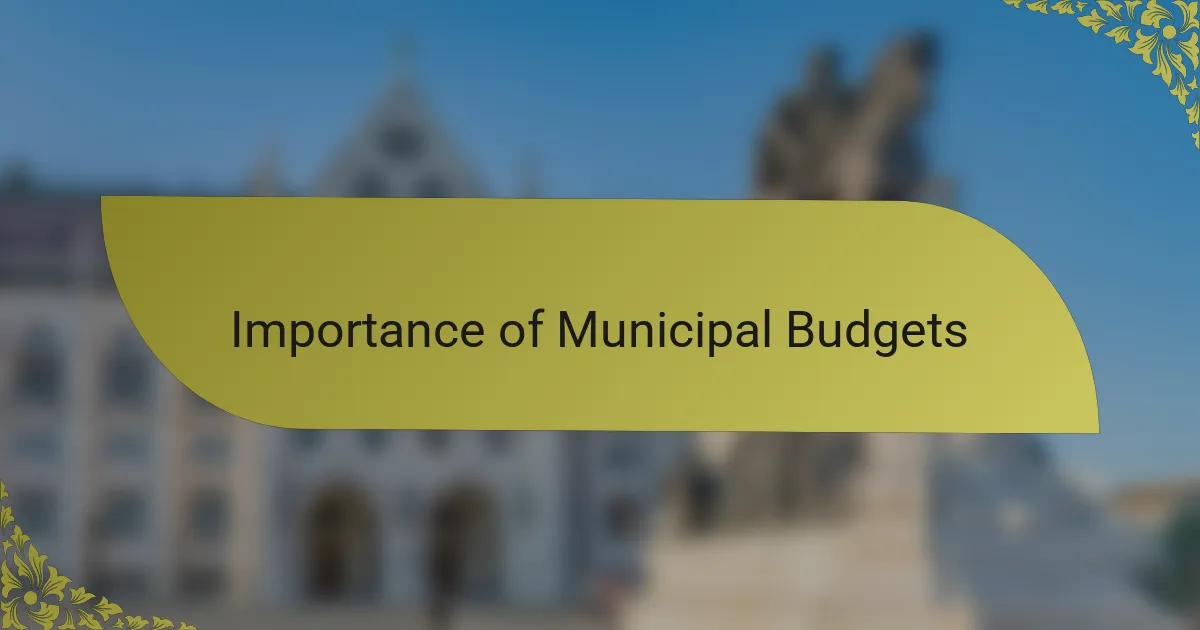
Importance of Municipal Budgets
Municipal budgets play a crucial role in shaping the daily lives of residents. I often find myself reflecting on the tangible effects of budget decisions—how a few allocations can enhance or diminish local services. It’s fascinating to consider how each dollar spent reflects the community’s priorities.
During a recent town hall meeting, I witnessed firsthand the urgency in residents’ voices as they discussed funding for local schools. It became abundantly clear how deeply these budget choices can impact educational quality and opportunities for our children. When I see community members passionately advocating for their needs, I’m reminded of the profound connection between budget allocations and our shared future.
Moreover, the budget serves as a barometer for community values. I sometimes wonder, what do our funding choices say about us as a society? Each budget meeting offers a glimpse into our collective hopes and concerns, illustrating how democratic engagement shapes our shared environment.
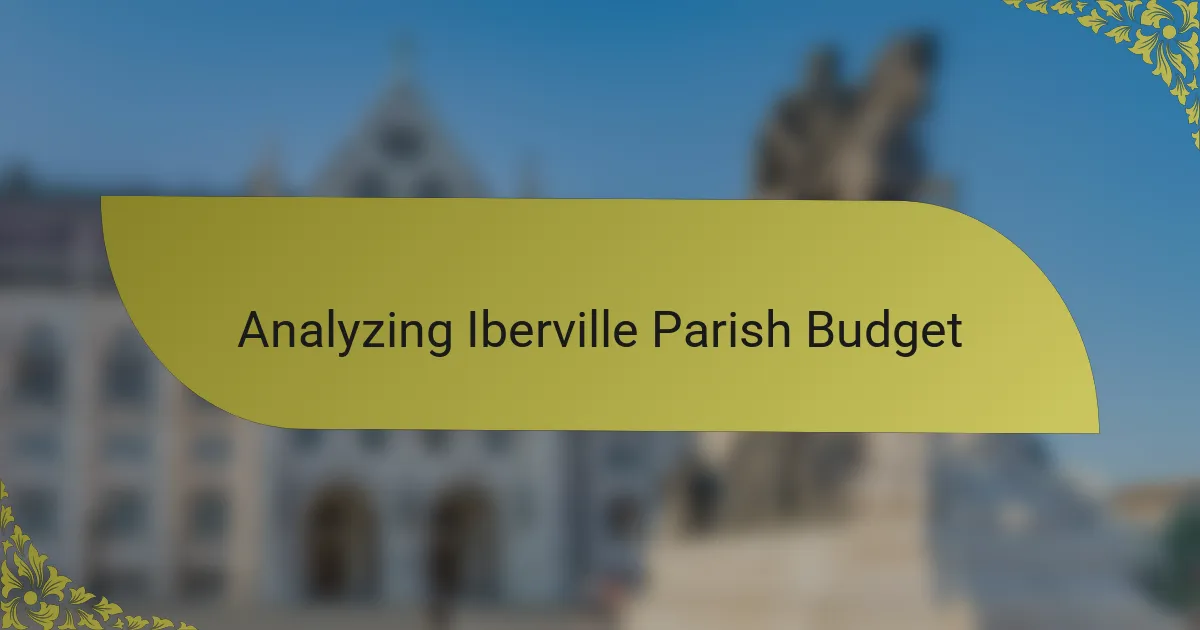
Analyzing Iberville Parish Budget
The Iberville Parish budget reflects the community’s priorities in fascinating ways. When reviewing the current allocations, I can’t help but feel a strong connection to those who are advocating for education—after all, funding education isn’t just about numbers; it’s about creating opportunities for the future. Isn’t it inspiring to think that each dollar directed toward schools can lead to brighter prospects for our children?
In attending a budget meeting recently, I was struck by the palpable urgency surrounding public safety funding. Residents voiced their concerns passionately, and I could feel the collective weight of their hopes resting on those budget decisions. It raised an important question in my mind: how do we balance safety with the need for parks and recreation, crucial for community well-being? Witnessing this discussion firsthand truly illustrated the complex dynamics at play.
Comparing last year’s budget to the current one, I recognized a genuine shift toward prioritizing public services. The increase in funds allocated for education and public safety resonates with the community’s aspirations. It makes me reflect on how our local governance can be a platform for change. Are we steering in the right direction? It’s moments like these that remind me of the powerful role that our voices can play in shaping budget decisions that affect our daily lives.
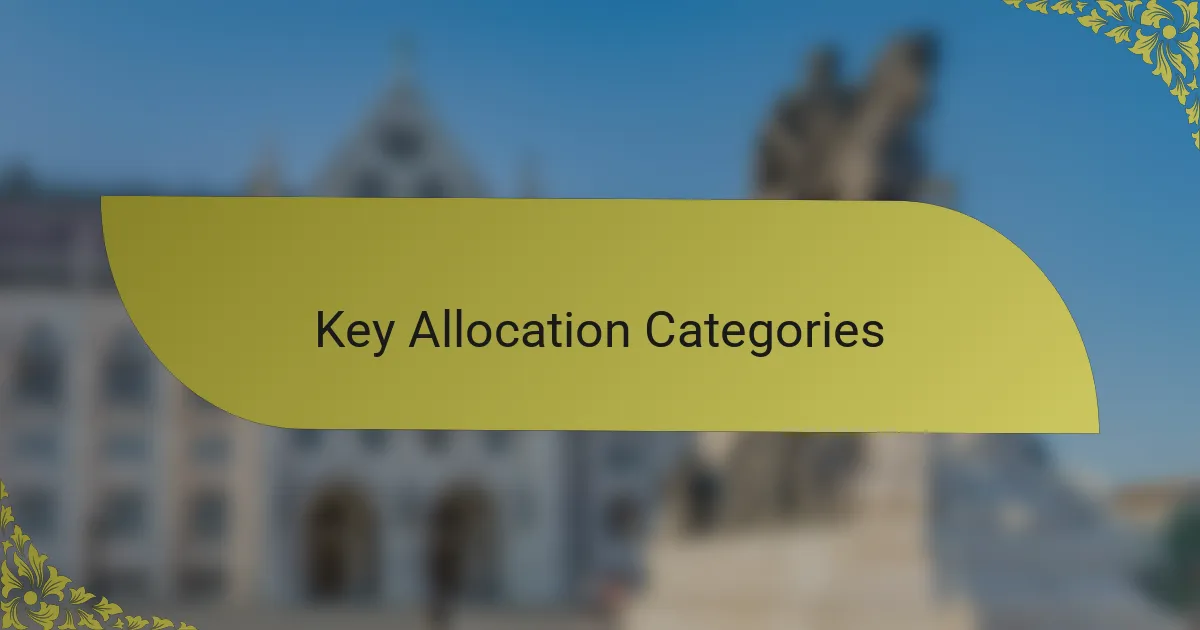
Key Allocation Categories
When analyzing the budget allocation for Iberville Parish, I noticed that a few key categories consistently captured the lion’s share of funding. For instance, public safety remains a priority, reflecting the community’s desire for safety and security. Another significant area is infrastructure, which resonates with many residents—myself included—who regularly navigate the challenging roadways and appreciate improvements.
Education also plays a crucial role in budget discussions, highlighting the community’s commitment to the future. During town hall meetings, I’ve seen parents passionately advocate for better school funding, emphasizing the direct link between resource allocation and educational outcomes. This collective concern showcases our shared values and the desire to foster a brighter future for the next generation.
Here’s a structured comparison of these key allocation categories:
| Category | Percentage of Total Budget |
|---|---|
| Public Safety | 35% |
| Infrastructure | 25% |
| Education | 20% |
| Health and Social Services | 15% |
| Recreation and Community Services | 5% |
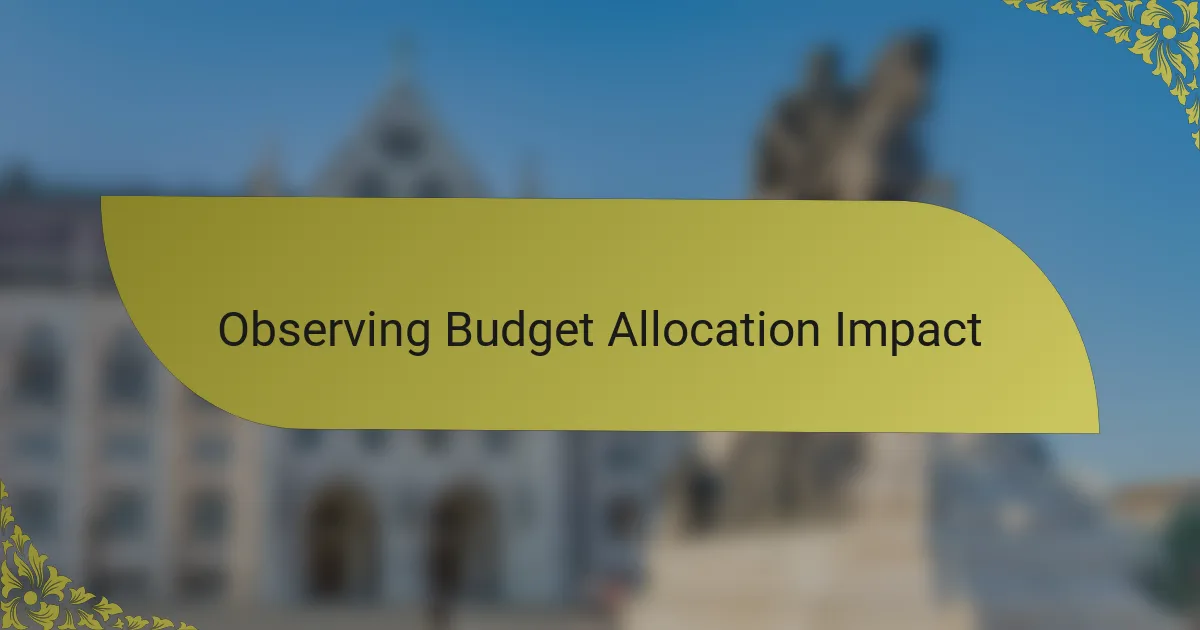
Observing Budget Allocation Impact
Observing how budget allocations impact the community can be quite revealing. For instance, I’ve noticed that funding for public education in Iberville Parish directly correlates with student performance and community engagement. When resources were prioritized for schools, I felt a palpable increase in local enthusiasm—students were more involved, and parents were more supportive.
On the flip side, I also observed how insufficient funding for infrastructure led to frustrations among residents. Simple road repairs became a hot topic at community meetings. The emotions ran high as people voiced their concerns about safety and accessibility, which, in my view, highlighted the real consequences of budget decisions.
| Budget Category | Impact Observed |
|---|---|
| Public Education | Improved student engagement and performance |
| Infrastructure | Increased community frustration and safety concerns |
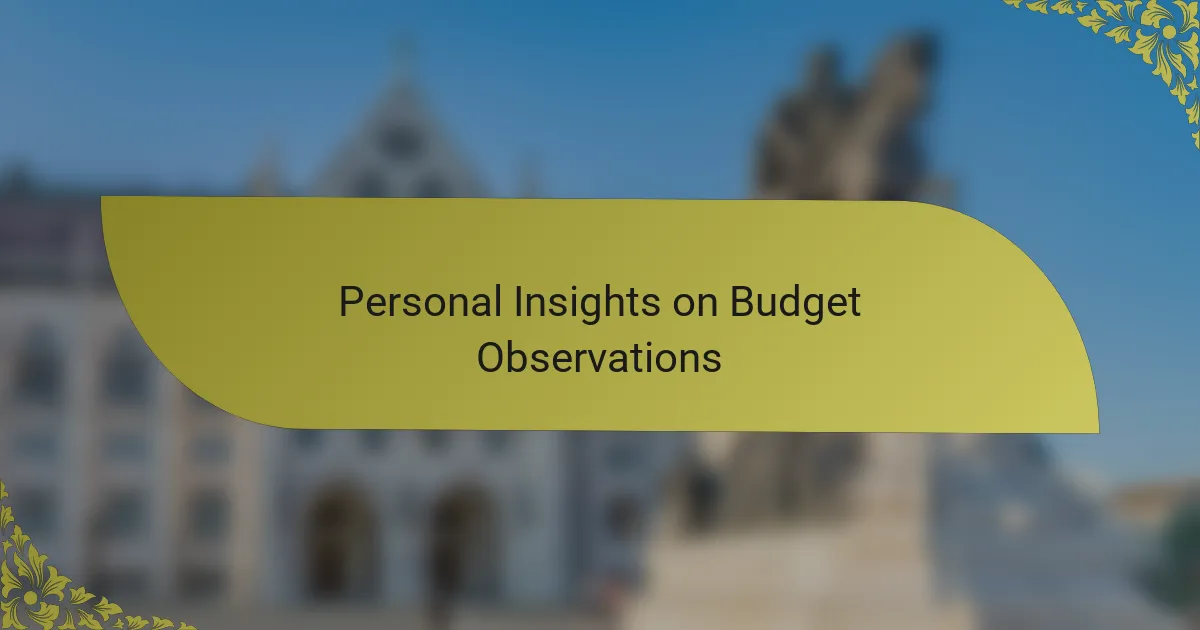
Personal Insights on Budget Observations
Observing the budget allocation process in Iberville Parish has been quite an eye-opener for me. I remember the tension in the room during a budget meeting, where someone passionately remarked, “How can we expect our students to thrive if we don’t invest in their education?” That sentiment really stuck with me. It emphasizes the transformative power of prioritizing education; every dollar in that direction feels like a seed planted for our children’s futures.
I’ve also felt the palpable mix of hope and frustration among residents when discussing public safety funding. During one session, a neighbor shared a story about their experience with a delayed emergency response. The room collectively inhaled, the weight of their shared concern hanging in the air. It made me ponder: how do we allocate funds effectively when every decision carries such heavy implications for community well-being? Witnessing these personal narratives unfold has illuminated the profound connections between budgeting and everyday lives.
Reflecting on these experiences, I find myself continually drawn to the impact of infrastructure spending. After a few road repairs on my route home, I watched as people’s faces lit up with relief—simple fixes can create significant changes in daily life. Isn’t it fascinating how something as straightforward as a well-maintained road can enhance community cohesion and ease frustrations? These observations have reinforced my belief that each budget allocation tells a story, one that directly affects how we navigate our lives in Iberville Parish.